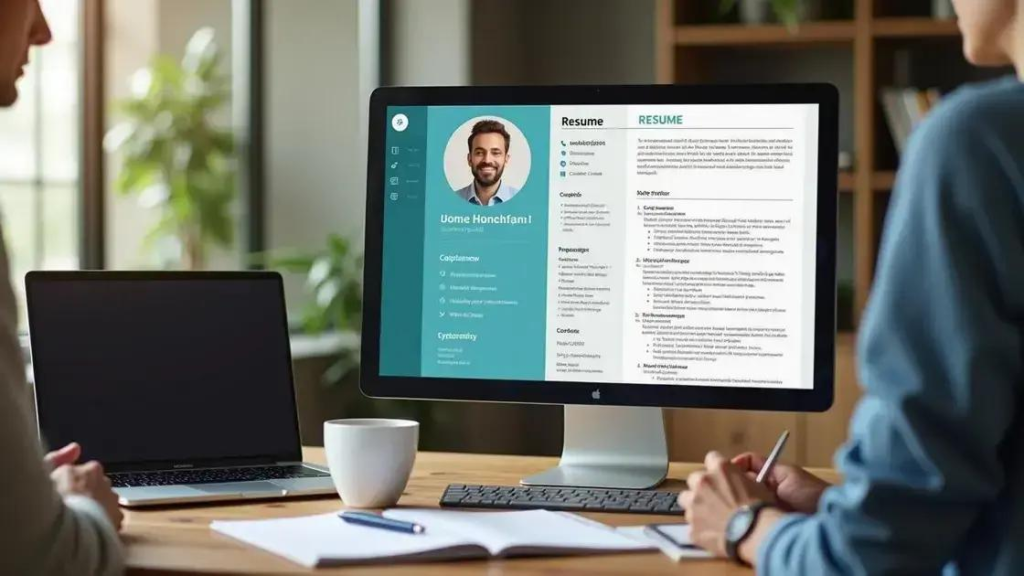Writing a strong resume involves tailoring it to specific jobs, highlighting relevant skills and quantifiable achievements, and including a personalized cover letter to connect with employers and showcase your personality.
Beginner resume tips help you enhance your job applications significantly. So, are you ready to improve your chances of landing that dream job? Let’s dive into what makes a resume truly shine!
The importance of a strong resume
The importance of a strong resume cannot be overstated. A well-crafted resume is your tool to make a great first impression on potential employers. It serves as a marketing document that showcases your skills, experiences, and accomplishments.
Why a Strong Resume Matters
Employers often receive many applications for a single position. A strong resume helps you stand out by clearly presenting your qualifications. It communicates your professionalism and attention to detail, which can reflect your work ethic.
Key Elements of a Strong Resume
Your resume should include clear sections such as contact information, a summary, work experience, education, and skills. Each section should be concise and tailored to the specific job you are applying for.
Making a Lasting Impression
Using action verbs and quantifiable achievements can help make your accomplishments more impactful. For instance, instead of saying “responsible for managing a team,” you can say “led a team of 5 to achieve a 20% increase in sales.” This brings clarity and evidence of your effectiveness.
Formatting for Readability
A strong resume should be easy to read. Use bullet points for lists and plenty of white space. Consider a clean layout that guides the reader’s eye. Avoid cluttered designs that might distract from your content.
Key components every beginner resume needs

Creating a strong resume involves several key components that every beginner should include. These elements ensure that your resume is both informative and appealing to employers.
Contact Information
Your resume should always begin with your contact information. Include your full name, phone number, email address, and LinkedIn profile if applicable. This makes it easy for employers to reach you.
Resume Summary or Objective
A brief resume summary or objective statement helps to highlight your career goals and what you bring to the table. It should be tailored to the specific job you are applying for and provide a snapshot of your qualifications.
Work Experience
List your work experience in reverse chronological order. For each position, include the job title, company name, location, and dates of employment. Under each job, use bullet points to summarize your main responsibilities and achievements. Focus on results and use strong action verbs.
Education
Include your educational background, starting from the most recent degree. Mention the degree obtained, the institution’s name, and graduation date. For those without much work experience, this section can be placed at the top of your resume.
Skills Section
Your skills should reflect the requirements of the job you are applying for. List both hard and soft skills relevant to the position. Be specific; instead of just saying “communication skills,” specify “excellent verbal and written communication skills.”
Certifications and Additional Sections
Consider adding any certifications, languages, or volunteer experiences that are relevant. Each of these components can give your resume an extra edge and show your dedication and versatility.
How to tailor your resume for specific jobs
To make your resume stand out, it’s essential to learn how to tailor your resume for specific jobs. This process involves adjusting your resume to fit the requirements of each job you apply for.
Understand the Job Description
Start by carefully reading the job description. Identify key qualifications, skills, and responsibilities that the employer emphasizes. These keywords and phrases are crucial for tailoring your resume.
Match Your Experience
When tailoring your resume, highlight experiences that align with the job description. For each relevant position, include bullet points that demonstrate how your previous work is applicable to the new role. Use the same language as the job posting when possible.
Showcase Relevant Skills
Your skills section should include both the hard and soft skills that match the job requirements. Make sure to list any specific tools, software, or methodologies mentioned in the job description.
Customize Your Resume Summary
If you include a resume summary or objective, customize it for each application. Use this section to briefly explain why you are an excellent candidate based on the specific job you are applying for.
Format and Design
Keep in mind that formatting can also be tailored. Use headings and bullet points that draw attention to the most relevant information for the role. A clean, professional appearance helps your resume to be easily scannable by hiring managers.
Using action verbs to enhance your resume

Using action verbs in your resume can significantly enhance its impact. These words convey confidence and dynamism, which can make your experiences more compelling to employers.
What Are Action Verbs?
Action verbs describe specific actions you have taken in your professional life. They help to clearly communicate your contributions and achievements. Examples include “led,” “developed,” “achieved,” and “managed.”
Why Action Verbs Matter
Employers often skim through resumes, and action verbs help grab their attention quickly. They add energy to your statements and make your resume more engaging. Using strong verbs can showcase your abilities effectively.
How to Use Action Verbs Effectively
Start bullet points with action verbs to describe your job responsibilities and accomplishments. For instance, instead of writing “responsible for sales team management,” you can say “led a sales team to exceed quarterly goals by 30%.” This shifts the focus from duties to achievements.
Choosing the Right Action Verbs
Make sure to choose action verbs that accurately reflect your contributions. Tailor them to fit the context of your experience. For example, use “coordinated” for organizing events or “designed” when discussing creative projects.
Variety is Key
Avoid repetitive action verbs by varying your word choices throughout your resume. This keeps your writing fresh and shows the range of your skills. Create a list of action verbs you can use for different situations to help with this.
Common mistakes to avoid in your resume
Avoiding common mistakes in your resume is crucial for making a good impression on potential employers. Here are some frequent errors to watch out for:
Spelling and Grammar Errors
Typos and grammatical mistakes can create a negative impression. Always proofread your resume multiple times. Consider using tools like spell checkers or asking someone else to review it.
Using a Generic Resume
Sending out a generic resume can hurt your chances. Take the time to tailor your resume for each job you apply to. Highlight the skills and experiences that are most relevant to the position.
Excessive Length
Keeping your resume concise is essential. Aim for one page if you have less than ten years of experience. Be selective in what you include, focusing on the most impactful experiences.
Lack of Quantifiable Achievements
Employers want to see the impact you’ve made in your roles. Instead of just listing duties, include quantifiable achievements. For instance, say “increased sales by 20%” instead of “responsible for sales.”
Ignoring Formatting
A cluttered or unprofessional format can make your resume hard to read. Use clear headings, bullet points, and adequate spacing. This helps hiring managers quickly find the information they need.
Not Including Keywords
Many companies use Applicant Tracking Systems (ATS) to screen resumes. Ensure you include relevant keywords from the job description. This will help your resume get past the initial screening.
Tips for formatting your resume effectively

Formatting your resume effectively is essential for making a positive impression. Here are some tips for formatting your resume to enhance its readability and visual appeal.
Choose the Right Font
Select a clean, professional font. Common choices include Arial, Calibri, and Times New Roman. Use a font size between 10 and 12 points to ensure readability.
Use Clear Headings
Organize your resume with clear headings for each section, such as “Work Experience,” “Education,” and “Skills.” This helps employers quickly navigate through your document. Make headings bold or slightly larger to make them stand out.
Be Consistent with Formatting
Consistency is key in formatting. Use the same style for dates, locations, and job titles throughout your resume. If you use bullet points for one job description, use them for all.
Maintain Adequate White Space
Don’t overcrowd your resume. Leave enough white space between sections and around the margins. This makes your document easier to read and gives it a polished look.
Keep to One Page
If you have less than 10 years of experience, aim to keep your resume to one page. Be concise and prioritize the most relevant information to fit within this limit.
Use Bullet Points for Accomplishments
Instead of long paragraphs, use bullet points to list your accomplishments and responsibilities. This format allows for quick reading and highlights your key achievements effectively.
How to showcase skills and achievements
Showcasing your skills and achievements on your resume is crucial for attracting the attention of hiring managers. Here are effective ways to highlight this information.
Identify Relevant Skills
Start by reviewing the job description to identify the skills required. Choose skills that directly match the job. This ensures employers can see you fit the criteria they seek.
Use a Skills Section
Create a dedicated skills section on your resume. List both hard and soft skills. Hard skills are measurable abilities like software proficiency, while soft skills are personal attributes like communication and teamwork.
Quantify Achievements
When discussing your achievements, use numbers to provide context. For instance, say you “increased sales by 30%” or “managed a project that was completed two weeks ahead of schedule.” This gives concrete evidence of your abilities.
Integrate Skills in Job Descriptions
While outlining your work experience, integrate relevant skills into your job descriptions. For example, instead of just stating your role, mention how you used a specific skill to achieve a goal.
Highlight Certifications and Training
If you have relevant certifications or training, include these in a separate section. This demonstrates your commitment to professional development and shows you have the qualifications needed for the job.
Include Projects or Volunteer Work
If you’ve worked on significant projects or engaged in volunteer activities that highlight your skills, include these experiences. They can showcase your abilities in real-world contexts, making you a more attractive candidate.
The role of a cover letter in your application

The role of a cover letter in your application is significant. It serves as a personalized introduction to your resume and can help you stand out from other candidates.
Personal Connection
A cover letter allows you to connect with the employer on a personal level. You can express your enthusiasm for the job and the company, sharing why you are genuinely interested in the position.
Highlight Relevant Skills
In your cover letter, emphasize skills and experiences that are particularly relevant to the job. This is an opportunity to provide context to your resume and explain how your background makes you a great fit for the role.
Showcase Your Personality
Unlike a resume, which is often more formal, a cover letter gives you the chance to let your personality shine. Use a friendly and engaging tone to give the employer a sense of who you are beyond your work experience.
Address the Hiring Manager
If possible, address your cover letter to a specific person. Research the company’s website or LinkedIn to find the hiring manager’s name. This small detail can make your application feel more tailored and thoughtful.
Reiterate Your Interest
Always conclude your cover letter by reiterating your interest in the position. Express your eagerness to discuss your application further and how you can contribute to the company’s success.
The Key Elements of a Strong Resume
Creating a standout resume is essential for job seekers aiming to catch the attention of employers. By incorporating a strong format, tailored content, and emphasizing relevant skills and achievements, you can significantly enhance your job applications.
A well-crafted cover letter also plays a vital role in connecting with employers and showcasing your personality. Remember that your resume and cover letter are your first opportunities to make a lasting impression.
By avoiding common mistakes and utilizing the tips provided, you can present yourself confidently and effectively to potential employers. Invest the time in perfecting these documents, and you will improve your chances of landing that desired job.
FAQ – Frequently Asked Questions about Beginner Resume Tips
How can I make my resume stand out?
To make your resume stand out, tailor it to the specific job by using keywords from the job description. Highlight your most relevant achievements quantifiably and ensure a clean, professional format. Use action verbs to convey your contributions effectively.
What should I include in my cover letter?
Your cover letter should include a personalized greeting, an introduction explaining your interest in the role, a brief overview of your relevant skills and experiences, and a closing statement expressing enthusiasm for the opportunity. For example, mention how your past experience aligns with the company’s goals.
Why is it important to avoid spelling errors in my resume?
Spelling errors can create a negative impression, making you seem careless and unprofessional. A single typo can lead hiring managers to overlook your qualifications. Always proofread your resume multiple times and consider using tools like Grammarly to catch errors.
What are the best fonts to use in a resume?
Use clean, professional fonts such as Arial, Calibri, or Times New Roman in sizes 10 to 12 points. These fonts are easy to read and lend a polished look to your resume, ensuring that hiring managers can quickly find the information they need.
How do I quantify my achievements on a resume?
Quantifying your achievements involves using numbers to illustrate the impact of your work. Instead of saying ‘improved sales,’ say ‘increased sales by 25% within six months.’ This provides a clearer picture of your success and effectiveness.
What should I do if I lack relevant work experience?
If you lack relevant work experience, focus on showcasing transferable skills gained from other jobs, internships, or volunteer work. Highlight any coursework, projects, or certifications related to the desired job, and emphasize your eagerness to learn and adapt.


